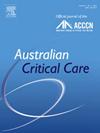可测量的呼吸肌训练对重症监护病房机械通气成人呼吸肌力量的影响是什么?系统回顾和荟萃分析。
IF 2.7
3区 医学
Q2 CRITICAL CARE MEDICINE
引用次数: 0
摘要
背景:危重疾病期间与机械通气相关的呼吸肌无力已得到证实。呼吸肌力量训练(RMST)包括吸气肌训练(IMT)和呼气肌力量训练(EMST)旨在解决这个弱点。本系统综述和荟萃分析的目的是评估RMST的有效性,RMST使用可测量负荷装置,以增加重症监护病房机械通气成人的呼吸肌力量。方法:根据系统评价和荟萃分析指南的首选报告项目进行,本综述纳入了2000年1月至2024年1月发表的重症监护病房患者的随机对照试验,患者年龄≥16岁,通气≥24小时,拔管前通过可测量负荷装置接受RMST (IMT或EMST)。排除术前/术后训练和其他呼吸无力原因的队列。检索范围包括电子数据库、临床登记、参考文献列表和SCOPUS。使用Cochrane Review Manager (RevMan)进行meta分析、敏感性和亚组分析。应用偏倚风险(RoB2)和推荐评分、评估、开发和评估工具评估呼吸肌力量。结果:14项研究(n = 844)符合纳入标准(7项低偏倚风险和7项高偏倚风险)。没有试验采用EMST。13项随机对照试验(n = 747)报告了对IMT的最大吸气压力(MIP)。结果显示,低确定性证据表明IMT使MIP增加6.9 cmH2O([95%可信区间{CI}: 4.9至9],i2 = 83%),敏感性分析后改善为高确定性证据(6.3 cmH2O [95% CI: 3.8至8.8],i2 = 34%, n = 397)。IMT还与缩短脱机时间(-1.9天[95% CI: -3至-0.8],I2 = 76%, n = 482)和缩短通气时间(-1.7天[95% CI: -3.8至0.3],I2 = 32%)相关。快速浅呼吸指数降低(-6.4次/分/升[95% CI: -16至3.2],I2 = 78%)。结论:本系统综述支持在危重患者中使用可测量负荷装置提供的IMT,在机械通气期间启动,以增加MIP措施。本综述中发现的其他潜在积极影响,如IMT减少脱机和机械通气持续时间,需要进一步确认。注册:本方案已在国际前瞻性系统评价注册(CRD42023431244)注册。本文章由计算机程序翻译,如有差异,请以英文原文为准。
What is the effect of measurable respiratory muscle training on respiratory muscle strength in mechanically ventilated adults in intensive care units? A systematic review and meta-analysis
Background
Respiratory muscle weakness, associated with mechanical ventilation during critical illness, is well established. Respiratory muscle strength training (RMST) including inspiratory muscle training (IMT) and expiratory muscle strength training (EMST) aims to address this weakness. The aim of this systematic review and meta-analysis was to assess the effectiveness of RMST, delivered using measurable load devices, to increase respiratory muscle strength in mechanically ventilated adults in the intensive care unit.
Methods
Conducted per Preferred Reporting Items for Systematic reviews and Meta-Analyses guidelines, the review included randomised controlled trials of intensive care unit patients aged ≥16 years, ventilated ≥24 h, receiving RMST (IMT or EMST) via measurable load devices before extubation, published from January 2000 to January 2024. Preoperative/postoperative training and cohorts with other causes of respiratory weakness were excluded. Searches covered electronic databases, clinical registers, reference lists, and SCOPUS. Meta-analyses and sensitivity and subgroup analyses were performed using Cochrane Review Manager (RevMan). Risk of bias (RoB2) and Grading of Recommendations, Assessment, Development, and Evaluation tools were applied to assess respiratory muscle strength.
Results
Fourteen studies (n = 844) met inclusion criteria (seven with low and seven with a high risk of bias). No trial employed EMST. Thirteen randomised controlled trials (n = 747) reported maximal inspiratory pressure (MIP) in response to IMT. Findings showed low-certainty evidence that IMT increases MIP by 6.9 cmH2O ([95% confidence interval {CI}: 4.9 to 9], i2 = 83%), improving to high-certainty evidence after sensitivity analysis (6.3 cmH2O [95% CI: 3.8 to 8.8], I2 = 34 %, n = 397). IMT was also associated with reduced weaning time (−1.9 days [95% CI: −3 to −0.8], I2 = 76 %, n = 482) and shorter ventilation duration (−1.7 days [95% CI: −3.8 to 0.3], I2 = 32 %).
Reductions in rapid shallow breathing index (−6.4 breaths/min/L [95% CI: −16 to 3.2], I2 = 78%) were also observed.
Conclusion
This systematic review supports the use of IMT delivered using measurable load devices, initiated during mechanical ventilation, in critical care patients, to increase MIP measures. Other potentially positive effects found in this review such as reduced weaning and mechanical ventilation durations in response to IMT need further confirmation.
Registration
This protocol was registered with the International Prospective Register of Systematic Reviews (CRD42023431244).
求助全文
通过发布文献求助,成功后即可免费获取论文全文。
去求助
来源期刊

Australian Critical Care
NURSING-NURSING
CiteScore
4.90
自引率
9.10%
发文量
148
审稿时长
>12 weeks
期刊介绍:
Australian Critical Care is the official journal of the Australian College of Critical Care Nurses (ACCCN). It is a bi-monthly peer-reviewed journal, providing clinically relevant research, reviews and articles of interest to the critical care community. Australian Critical Care publishes peer-reviewed scholarly papers that report research findings, research-based reviews, discussion papers and commentaries which are of interest to an international readership of critical care practitioners, educators, administrators and researchers. Interprofessional articles are welcomed.
 求助内容:
求助内容: 应助结果提醒方式:
应助结果提醒方式:


